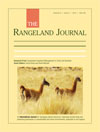The Rangeland Journal
Volume 34
Number 4 2012
RESEARCH FRONT: Sustainable Grassland Management in China and Australia
Poisonous plants are a serious cause of natural grasslands degeneration in China. This review describes the distribution of these poisonous plants and their impact on livestock production and addresses the issues of integrated control measures and the development of appropriate livestock management systems that could be implemented. These results will provide a very important reference for controlling poisoning disease caused by these plants and the use of control measures for them.
China has 393 million hectares of grassland. The study area was the total grassland of six provinces in the north and west,70% of Chinese grassland. The aim of this paper is to find the climate change trends and its influences on grassland using AVIM-GRASS and other models, and data from long-term meteorological stations (1961–2007). An average decrease in annual available herbage production and carrying capacity of livestock in most of the main grassland areas were found due to warmer and dryer conditions in north, small increase of precipitation in west. The results indicate that actual livestock is controlled in most of main grasslands in China according to climate change to recover the deteriorated grassland.
Increasing hot and dry and fluctuating climate in desert steppe of northern China has a profound impact on the economy and the livelihood of rural communities there. The authors studied the herdsmen’s perceptions and management adaptations to highly variable climate and found that herdsmen had good perception of recent short-term climate change and drought, but have no active measures in place to meet challenges of predicted climate change in future. It’s needed to raise the herdsmen’s awareness and improve their preparedness to adapt to the future climate.
Plant species being developed as new crops are often ones traditionally used by Indigenous people. In addition to the need to develop agricultural production knowledge for each new crop, a complex series of other factors comes into play concerning cultural heritage. These include consent of original custodians; respect and acknowledgement of their traditional knowledge to be exploited; totemic, kinship and spiritual associations that may be impacted; establishing benefit sharing for the hereditary stewards; and protection of collective traditional intellectual property.
Carrichtera annua, Ward’s Weed, is a widespread weed of southern rangelands of Australia and there is currently no effective control strategy outside agricultural systems. Field and glasshouse experiments were used to measure stages of the life cycle of C. annua that could be targeted for control. Two seedbanks, an aerial pod seedbank and a soil seedbank, are key features contributing to the success of this species as they are subject to and protected from contrasting pressures. The population can be replenished by either seedbank in one generation, hence both seedbanks need to be targeted to allow successful control.
Alhagi sparsifolia, a dominant species distributed in south rim of Taklamakan Desert in NW China, is important not only for local livestock but also for oases ecological safety and sustainability management. The results, based on two years experiment on cutting and burning in different time, show that cutting in fall appears to be a useful treatment for increasing the production and survival of A. sparsifolia. This study provides useful reference for arid/extremely arid rangeland management.
The old tourist road between Uluru (Ayers Rock) and the Olgas (Kata Tjuta) was badly degraded because of poor location and some indigenous sites were threatened. To rehabilitate the road, the surface was ripped, regraded and top soil imported from dune systems added; vegetation growth was monitored over eight years. Revegetation progressed well with a range of plant species typical of those at the source area; erosion was totally reduced.
For rangeland managers it is important to know the spatial variation of grazing pressure caused by livestock. GPS collars can help to quantify patterns of grazing intensity in space and time. We found significant variation in the daily walking distance between seasons according to fodder availability, different weather conditions and day length. Grazing intensity maps showed highest values near settlements. Management strategies should focus on problem areas near settlements and also take seasonal dependent patterns into consideration.
The length of time that seeds can survive varies greatly, from less than a year up to several decades. In this study we quantified seed bank persistence of bellyache bush (Jatropha gossypifolia L.), one of Australia’s worst weeds, and found that seeds persisted for between 3 and >10 years depending on biotic and abiotic influences. This information provides land managers with an indication of the potential duration of control programs, based on the length of time over which seedlings could emerge from the seed bank in the absence of further seed input.
In rangelands, many of the wildlife reintroductions aim at recovering ecosystem functionality. Habitat selection by reintroduced guanacos (Lama guanicoe) was evaluated in a heterogeneous mountain rangeland of central Argentina and it was found that availability of high quality forage and plant growth form largely explained habitat use. The information obtained can be used in an ongoing guanaco reintroduction project in Quebrada del Condorito National Park, and can be incorporated in restoration strategies of this fragile ecosystem.




